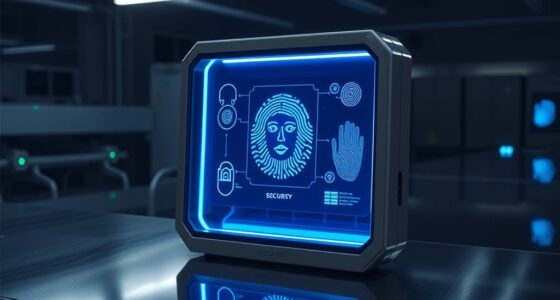Digital twins help you save billions in manufacturing errors by creating virtual models of your assets and processes. They enable you to perform predictive maintenance, identify inefficiencies, and test process changes safely before real-world implementation. With real-time data, you can quickly troubleshoot issues, optimize operations, and prevent costly mistakes. This technology is transforming industries into smarter, more reliable systems. Keep exploring how digital twins can further revolutionize your manufacturing efficiency.
Key Takeaways
- Digital twins enable real-time monitoring and predictive maintenance, preventing costly equipment failures before they occur.
- Virtual process testing helps identify inefficiencies and optimize operations without physical disruptions, reducing errors.
- Simulation of performance improvements allows manufacturers to implement changes proactively, minimizing costly mistakes.
- Enhanced collaboration through shared digital models accelerates problem-solving and reduces miscommunication-related errors.
- Overall, digital twins support billions in annual savings by early detection of issues and continuous process optimization.

Have you ever wondered how industries are transforming their operations with cutting-edge technology? One of the most revolutionary tools gaining momentum is the digital twin. This technology creates a virtual model of a physical asset, process, or system, allowing you to simulate, analyze, and optimize performance in real-time. With virtual modeling at its core, digital twins enable you to see exactly how your equipment behaves under various conditions without risking actual machinery. This virtual environment serves as a digital replica, making it easier to troubleshoot issues, plan maintenance, and improve overall efficiency.
Digital twins create virtual replicas to optimize performance and troubleshoot issues in real-time.
Predictive maintenance is a key benefit that digital twins facilitate. Instead of waiting for machines to break down, you can monitor their condition continuously through sensors feeding data into the virtual model. By analyzing this data, you can predict when a component is likely to fail, schedule maintenance precisely when needed, and avoid costly downtime. This proactive approach not only reduces unexpected failures but also extends the lifespan of your equipment. As a result, you save significant amounts of money by preventing errors before they happen and optimizing maintenance schedules.
Digital twins also help you identify inefficiencies that might otherwise go unnoticed. When you simulate different scenarios within the virtual model, you gain insights into how to improve processes, reduce waste, and enhance quality. For example, you can test adjustments to production lines in the digital realm before implementing them physically, ensuring you don’t disrupt operations or incur unnecessary costs. This capability allows you to make data-driven decisions quickly and confidently, ultimately boosting productivity and reducing errors that can lead to costly manufacturing mistakes.
Furthermore, digital twins facilitate collaboration across teams by providing a shared, real-time view of assets and processes. Engineers, operators, and managers can access the same virtual model, discuss issues, and implement solutions more efficiently. This transparency fosters better communication and quicker responses to potential problems. The integration of virtual modeling and predictive maintenance creates a feedback loop that continually refines your operations, driving down error rates and maximizing output quality.
Additionally, digital twins can incorporate Kia Tuning options, allowing manufacturers to simulate performance enhancements like engine tuning, suspension upgrades, or aesthetic modifications in a risk-free environment before actual implementation. In essence, digital twins are transforming manufacturing by making operations smarter, more reliable, and cost-effective. With virtual modeling guiding predictive maintenance, you’re empowered to catch problems early, optimize processes, and save billions in errors annually. This innovation isn’t just a future concept; it’s a present-day reality that’s reshaping industries worldwide, giving you the tools to stay competitive in a rapidly evolving landscape.
Frequently Asked Questions
How Do Digital Twins Impact Workforce Training and Skills Development?
You can see that digital twins greatly impact workforce training and skills development by offering immersive experiences with augmented reality. This technology allows you to practice complex tasks in a safe, virtual environment, leading to better skill enhancement. As you engage with digital twins, you develop hands-on expertise faster, reducing errors and increasing efficiency. This approach prepares you more effectively for real-world challenges, ultimately boosting your confidence and competence on the job.
What Are the Main Challenges in Implementing Digital Twin Technology?
Did you know that 70% of digital twin implementations face significant challenges? When you implement digital twin technology, you often struggle with virtual integration and achieving accurate real-time simulation. These hurdles include high costs, data security concerns, and the need for specialized skills. Overcoming these challenges requires strategic planning, but successful integration can drastically improve efficiency and reduce errors in manufacturing.
How Secure Are Digital Twins Against Cyber Threats?
You might wonder how secure digital twins are against cyber threats. While they offer great benefits, cybersecurity risks and data privacy concerns are real. Hackers could access sensitive manufacturing data or manipulate virtual models. To protect yourself, guarantee robust encryption, regular security updates, and strict access controls. Staying vigilant and proactive helps safeguard your digital twin systems from potential cyber threats, keeping your operations safe and data private.
Can Digital Twins Be Customized for Small Manufacturing Firms?
Think of digital twins as a tailor-made suit—you can customize them to fit your small business perfectly. Yes, digital twins can be tailored with various customization options for small manufacturing firms. These options allow you to adapt the technology to your specific needs, making it more accessible and affordable. By choosing the right features, you can optimize your operations without overextending your resources, turning a complex tool into your business’s best fit.
What Is the Typical ROI Timeframe for Digital Twin Investments?
You’re probably wondering about the ROI timeline for digital twin investments. Typically, you can expect an investment payback within 6 to 18 months, depending on your implementation scope and operational efficiency gains. Digital twins help streamline processes, reduce errors, and boost productivity, so your ROI timeline is often quicker than traditional tech upgrades. Keep in mind, the key is aligning your goals and tracking performance improvements closely.
Conclusion
Digital twins act like your company’s crystal ball, revealing potential errors before they strike. By catching issues early, you prevent costly mistakes that can drain your resources like a leaky faucet. Embracing this technology is like having a second pair of eyes, guiding you safely through the manufacturing maze. With digital twins, you’re not just avoiding errors—you’re steering your ship through calm waters, saving billions and turning challenges into opportunities for smooth sailing.









